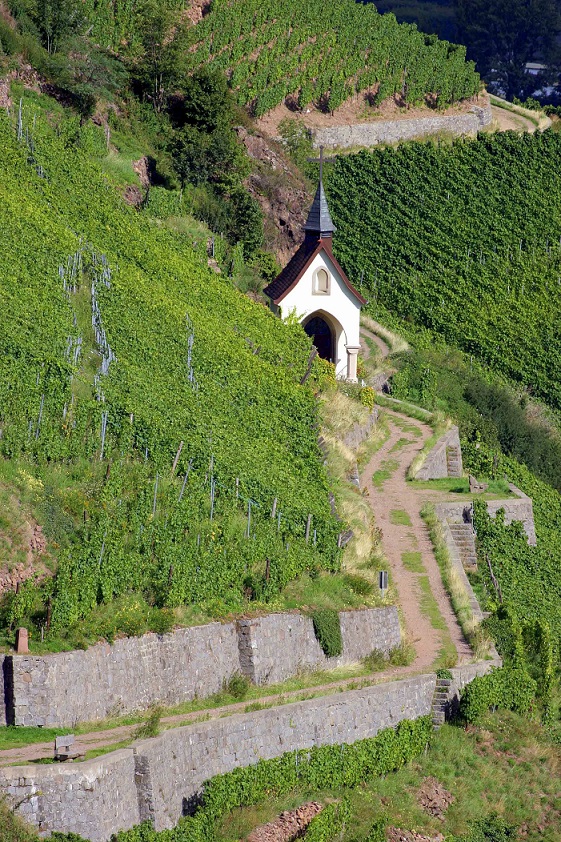At the risk of adding to the cacophony of opinions, I’d like to chime in with a thought in the hope of rescuing the term. It is, after all, an important topic, one that fascinates and tantalizes makers, marketers and drinkers with its implication of a connection between wine and place – the relationship that sets wine above all other beverages.
Most commentators on minerality point out the ambiguity of the term. It’s true. There is little consensus on how and when to apply it to wine. Combined with its swelling use, minerality is running the serious risk of becoming meaningless. Maybe it is already. In countless studies and tasting experiments, we’ve seen that individual tasters, and even whole countries and cultures, don’t agree on what exactly minerality is. As it stands, if minerality were a colour, it would be white – a mishmash of everything in the spectrum from aroma to taste to texture and combinations thereof (everything, that is, except colour; I’ve yet to read a description that alludes to the 'minerally' hue of a wine).
'A sort of little weir in the flavour stream'Most by now have moved beyond the scientifically untenable idea that minerality comes from the absorption of geological minerals by vine roots, which then directly cause a minerally taste in wine. Yet just about everything else has been fingered, from acids to salts, sulphur compounds, tactile sensations, cool climates, a host of various aromatic molecules, a lack of other wine flavours, and more, to invoke minerality. One of my favourite, if conceptually elusive descriptions, is California winegrower Randall Grahm’s deliciously nebulous take: “a sort of little weir in the flavour stream of the wine, slowing down its flow, but ultimately contributing to the qualities of dimensionality and length.”
'The solution to saving minerality lies with defining it'Science, of course, has been marshalled to sort out the confusion. But not surprisingly, researchers have been baffled by minerality. And that’s not least because they’re not sure what to look for. Most research starts out by having a group of tasters look for 'minerality' in a group of wines, and then try to figure out what those tasters mean. But the solution to saving minerality lies with defining what minerality is first, so that one knows what sort of needle to go searching for in the haystack, and then get people to agree on the definition. If minerality is ever to have any real meaning, and universal use, we have to define it.
But what dimension of minerality might we all agree upon? Consensus on aroma/flavour-based minerality is unlikely, for several reasons. Although most would agree that wine descriptions are generally based on metaphors, in some important ways they’re not. Frequently applied fruity, herbal or floral descriptors used by wine tasters, for example, have literal, not metaphorical equivalents in the ‘real’ world. That is to say, the molecules responsible for these smells/flavours are identifiable and measurable in wine, as well as in the fruits or flowers or vegetables used to describe their perception in wine.
Some more obvious examples include the methoxypyrazine group of odorous molecules, which are measurable in both wine (Sauvignon Blanc, Cabernet Franc and Sauvignon, etc) and in green peppers. You are literally smelling the same family of molecules in your wine that gives a green pepper its particular green pepperiness. Or, the rotundone shared by peppercorns and wines made from Grüner Veltliner or Syrah, the cis-rose oxide, linalool and geraniol of lychees and Gewürztraminer, the eugenol of cloves and barrel-aged wines, or the diacetyl found in both real butter and ‘buttery’ wine. These compounds and their smells are not metaphorical; they are measurable and real in wine and in their natural world equivalents. Although I’m sure you don’t think there are actual cherries in your wine, you can still smell a very cherry-like aroma in it (benzaldehyde) with scientific confidence.
The problem with geological minerals – rocks – is that they have no real-world aromatic equivalents. Minerals are odourless. Inert. By definition, they are naturally occurring, solid, inorganic substances, with a highly ordered atomic [crystalline] structure, and thus non-reactive and non-volatile. Any aromas arising from rocks can only be due to foreign organic substances that have alighted on their surfaces, such as bacteria, algae, or various moulds, lipids, etc, which appear to give the rocks an odour.
So, any aromatic correspondence between rocks/minerals and wine is necessarily pure fantasy, basically, “metaphors, mental associations, or recollections of some past encounter involving rocks, and not the direct taste [smell] of geological things”, as Alex Maltman, professor emeritus of earth sciences at Aberystwyth University in Wales, and author of Vineyards, Rocks, and Soils, writes. Claims of “smells like slate” or “limestone” are just people conjuring up what the aromatic profile for these particular types of rock might be, if they had any aroma, or recalling the smell of organic substances on or nearby these rocks encountered in situ.
'The one exception...'(The one exception to this rule is elemental sulphur, which, as we know, does have an odour. If any aroma were a candidate for genuine minerality, sulphur would be it. This helps explain why wines high in sulphur compounds such as benzenemethanethiol, methanethiol or hydrogen sulphide, often described as ‘flinty’, ‘oyster shell’, or ‘reductive’, are often also described as ‘mineral’. But the trouble yet again is that these particular compounds, except hydrogen sulphide, are organic. They can result from struggling yeasts in nutrient-poor musts, a feature of mineral (nutrient)-poor terroir and thus a feature of place (assuming no yeast nutrients like diammonium phosphate (DAP) are added during fermentation), but even more frequently these sulphur compounds – for which hydrogen sulphide is used as a building block – result simply from late season sulphur sprays too close to harvest, which allows sulphur to find its way into must/wine and cause that flinty-reductive smell, quite unrelated to vineyard geology or soil. And those wines that do reek of actual sulphur, from the overenthusiastic addition of inorganic potassium metabisulphite (releasing SO2), are hardly where we want to apply the term minerally, and likewise has nothing to do with place in any case.)
'Minerality' can, of course, be used in this purely metaphorical sense, indeed it frequently is. I like the metaphorically minerally smell of wet river stones or hot pavement after the rain, even though I know I’m not actually smelling minerals. But in order to define minerality in this metaphorical, aromatic sense in a scientifically responsible way, we’d all have to first agree on the specific metaphor(s), and then the compounds responsible, so we could establish a legitimate correlation between wine composition and mineral aroma/flavour, as we do with other aromas and flavours.
But since useful metaphors rely largely on shared experience, which segment of the wine drinking population’s shared experiences should be used to create the definition? I think it unlikely that winegrowers on Etna, or in the Negev desert, or Patagonia, or Chablis will all agree on a common metaphor for their past encounters involving rocks.
'Exclusive enough...'And the wine world is already notoriously exclusive enough. The industry has been very good at creating descriptive feedback loops, reinforcing stereotypes created mostly by Eurocentric wine commentators and their shared, limited experiences. Even our common fruit, vegetable, spice and flower descriptors reflect a pretty narrow band of what’s available worldwide.
To define the term mineral using the experiences of an arbitrary group of commentators would make it even more pretentious, and ultimately, limited in use.
So, let’s forget about minerally aromas/flavours, and turn to a potentially more inclusive, more literal definition of minerality. Textural or tactile sensations are often invoked in the quest for minerality, like “licking rock dust”, but they are of little help. Astringent sensations, described as gritty, grainy, dusty, chalky, or whatever, are, for one, difficult to assess and describe. Intensity is especially tough to agree upon between individual tasters and has much to do with the taster’s state of hydration and whatever else they’ve consumed before – it’s an accumulative sensation that builds in intensity with repeated exposure. And besides, polyphenols, the compounds largely responsible for astringency in wine, are organic. So, it’s back to metaphors. No doubt vineyard site/soil structure/geology play a role in polyphenol concentration, but tactile sensations alone are not good candidates for a universal minerality mantle.
'The secret to minerality’s salvation'So how about taste sensations? I’m referring in particular to bitterness and saltiness. Herein, I believe, lies the secret to minerality’s salvation. This is the line of questioning I’ll be pursuing in an upcoming book on wine chemistry, co-authored with Dr Benoît Marsan, professor of chemistry and wine chemistry at the Université du Québec à Montréal. Research on both chemical composition and taste is under way, with a focus on salty and bitter substances.
“Salts are composed of cations (positively charged ions) and anions (negatively charged ions). Cations are inorganic, but anions can be both inorganic, such as chloride (Cl-) or sulphate (SO42-) ions, as well as organic such as bitartrate ([C4H5O6]-) ions. When salts contain inorganic (mineral) anions and cations, scientifically they fit the bill to start the discussion,” says Dr Marsan. Furthermore, salts are composed of soluble ions, a pre-requisite to be taken up by vine roots, and ions are found in relatively high concentrations in wine. And they provoke a taste sensation recognisable by all humans (allowing for variations in thresholds of perception), and thus universal.”

Alsatian winegrower Olivier Humbrecht MW (above) is a proponent of the salty minerality definition. “Minerals in their globality have a taste and will without doubt influence the palate, length and structure of a wine,” he says, but, “more importantly, they will leave a saline savour, enhancing the touch of the wine on our taste buds and transforming its length and character.”
Sodium (Na+) forms the most potent (salty) type of salt, namely sodium chloride, though it is not the most likely source of saltiness in wine. For one, although many soils contain available sodium, released by the weathering of soil minerals and the underlying rock in a vineyard, grapevines actively reject sodium ions; they are toxic, and generally detrimental to wine quality. Wine Australia’s research arm even warns growers of potentially harmful sources of soluble sodium chloride, such as saline ground aquifers and water tables used for irrigation, a feature in many drought-stricken areas, of which Australia has many. Likewise, Felipe Müller (below) of Viña Tabalì in Chile reports the near-catastrophic levels of accumulated salinity in water sources in the Limarí Valley after a multi-year drought, threatening the very existence of his vineyard.

Salt’s toxicity to grapevines explains the generally low concentration of sodium found in wines, from non-detected to about 300mg/L, but very often less than 100mg/L. More than about 300mg/l would be needed to be perceptible.
‘Seaside-grown wines can indeed have measurable and perceptible sodium’A non-toxic exception is sodium delivered by saline aerosol in seaside vineyards. Canary Islands winegrower and researcher Juan Jesús Mendez Siverio of Viñatigo on Tenerife, to give just one example, reports that vineyards exposed to marine winds during the vegetative cycle produce measurably salty wines. “In the case of the Canary Islands, vineyards facing north at 600m or less are exposed to the Alisios winds, which are so loaded with saline aerosol that they can burn the edges of leaves and berry skins. Unless there is considerable rainfall before harvest to wash the salt off, there is a notable increase in salinity in the wines.” Seaside-grown wines can indeed have measurable and perceptible sodium, and I think even terroir purists must agree that proximity to an ocean is surely part of the overall expression of a place. (Photo below shows a strong current of Alisios winds flowing beneath the 'sea of clouds' on Tenerife’s north side, depositing saline aerosol on vines.)

But there are other exogenous sources of sodium that are antithetical to the concept of terroir-driven, salty minerality. These include cleaning agents added to drip-irrigation systems, eg. sodium hypochlorite, as well as fertilisers and gypsum applied to soil, or bentonite treatment or the addition of sodium metabisulphite, or the use of some fining agents in the winery, among others. Since any successful definition of minerality must be coupled to a concept of quality and place to gain any traction, sodium alone is therefore tricky.
But sodium is not the only source of saltiness. The main mineral ion in wine is potassium (K+), not sodium. Potassium may yet provide the needed underpinning to minerality. It is found in sufficient quantities in wine to have a taste impact and contributes both bitterness and a vaguely salty taste. It is abundant in certain soils, and thus linked to place. And vines need potassium to grow, so roots are happy to lap it up.
Coupled with other tasty soil-borne ions (calcium, magnesium, iron, etc), which, while insufficient in concentration alone to directly impact taste, may, in combination, contribute to taste sensations, potassium could form a basis for our definition of literal minerality. And we should agree on a range of intensity and nuance of salty and bitter tastes in wine, allowing the particular mineral composition of soils to be expressed, which is, after all, what minerality is supposed to be about.
'A salty sensation is also elicited by succinic acid'There’s more... Aside from potassium, a salty sensation (alongside sour and bitter tastes) is also elicited by succinic acid, a weak acid found in wines in the range of 200-700mg/L, occasionally even higher. That’s enough to have an influence on taste at the higher end, and it has been already called into the minerality debate. Succinic acid is not present in grapes, but it is one of the most abundant by-products of alcoholic fermentation (after ethanol, CO2 and glycerol). Malic acid can be partially converted into succinic acid, and wild (indigenous) yeast fermentations in particular have been shown to yield higher succinic acid levels, especially in turbid and warm musts. And yeast species and strains also have a significant impact on the amount produced, another plus for terroirists who believe that native yeasts are part of terroir expression. Some vineyards, when allowed, will naturally yield more salty-bitter-sour wines, higher in succinic acid.
Including succinic acid requires considering winemaking techniques (warm, turbid ferments) in our definition of minerality, moving it away from the exclusive result of place. But process is part of terroir; great wine is a product of the relationship between people and places. I don’t think anyone would argue that there are better and worse ways to farm and produce wine. The human factor must be recognised. So, if salty-bitter tastes are to be described as minerality, the presence of salty acids, and the various techniques used to enhance them must be considered and measured. And we won’t worry that succinic acid is organic; in this case it produces a legitimate metaphorical mineral sensation representing actual minerals (salts, along with metals).
'Foils for food'Finally, high total acidity also stimulates our salt receptors (ion channels), in addition to sour receptors, giving an impression of saltiness. This is usually coupled with astringency (a result of low pH), adding a tactile dimension. These effects combined could legitimize all those who have included high acid and chalky-textured wines on their list of the most mineral, but now under the umbrella definition of salty-bitter of minerality (while dashing the hopes of warm climate producers farming low acid grapes). It also jives nicely with the prevalent belief that mineral wines are also especially “gastronomic”, or “food-friendly”, as high acid, salty-bitter wines make particularly useful foils for food.
For those thinking that saltiness will be easy to fake, Humbrecht has some cautionary words: “If salinity expressed on the palate will become the new way to judge quality and soil influence, I guess that it won’t take long for some clever oenologists to figure out how to change/add this taste in wines. Fortunately, adding ‘salts’ or minerals in a wine will certainly not make it taste better and could cause other serious problems like increasing the pH too high.” Besides, minerality alone, as it stands now or as I’m proposing, doesn’t guarantee a top-quality wine. Everything else has to be in place, too.
'No single region, grape variety, type of soil or geology will have a monopoly on minerally wines'The good news is that, considering the wide-ranging (natural) sources of various salty-bitter taste catalysts, and the methods available to enhance or encourage their presence in wine, no single region, grape variety, type of soil or geology will have a monopoly on minerally wines. But the term should be reserved only for those wines carefully farmed and produced to maximize sugar-free dry extract, a measure of solid material in wine, essentially minerals, preserving minerality’s relationship to quality. As Humbrecht explains: “This measurement [dry extract] is in fact directly linked to the way the vines grew in their soil, how effective the root system was, how small the crop was (higher yields = lower dry extract) and how interesting the soil was. No excessive additions of minerals into a soil will increase the dry extract of a wine.”
(Photo below shows Domaine Zind-Humbrecht’s volcanic Grand Cru Rangen de Thann vineyards in Alsace, source of wines with the highest dry extract year after year.)

And while winemaking techniques can’t really increase dry extract (aside from questionable ones like reverse osmosis), they can certainly decrease it. Shorter time on lees, all fining techniques and filtrations (especially sterile filtrations) will ultimately affect the colloidal composition of a wine and thus its mineral composition and abundance, lessening a wine’s salty-bitter minerality, along with quality.
Thus, wine produced from healthy, low-yielding vines, carefully farmed in a soil with sufficient, available mineral ions, transformed in a way to maximize dry extract as well as the concentration of succinic acid, and thus yielding a wine with a unique combination of nuanced salty-bitter-sour tastes, would be the very definition of a minerally wine.
Definition
A minerally wine is a one produced from healthy, low-yielding vines, carefully farmed in a soil with sufficient, available mineral ions, transformed in a way to maximize dry extract as well as the concentration of succinic acid, and thus yielding a wine with a unique combination of nuanced salty-bitter-sour tastes.Every wine drinker around the world will be able to understand what mineral means, and more importantly, perceive it, too, at least with some experience or training. And what’s more, claims of ‘mineral’ would be scientifically verifiable. Researchers would be able to quantify the amount of salty-bitter compounds in a wine through various methods (including electrical conductivity, a measurement of the free ions in a solution), which, when applied to a baseline (and a topline) for saltiness and bitterness, could support or debunk the claim. It will take some experience to distinguish the real from the fake, but that’s what wine tasters are supposed to be able to do.
With this, the term might actually survive since it would have a definable, measurable meaning.
Let’s hope it’s not too late for minerality. Let’s rescue it from overuse, abuse and ambiguity, its willy-nilly application wherever one wants to conjure up quality and relation to place.
Let’s put the 'mineral' back in minerality, and put an end to the need for articles such as this.
'Let’s put the 'mineral' back in minerality'John Szabo is a Canadian master sommelier, author, and principal critic for WineAlign.com. His latest book, Volcanic Wines, Salt, Grit and Power, garnered international acclaim; his next title will be on Wine Chemistry.
More on minerality
Minerality: The debateIWC co-chair Dr Jamie Goode discusses the subject with wine buyer Steve Daniel – as they taste 11 ‘minerally’ wines from around the world…
Minerality: Second opinion
Doctors’ view of wines made from grapes grown in a meteorite crater...
Minerality: Managing the aroma and flavour in the face of climate change
Exploring the latest research into the subject...
Minerality: IWC judges’ view
It’s the word they would most like to see banned from tasting notes…

 English
English French
French







.png)



